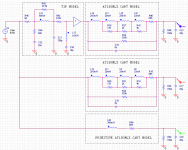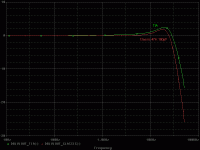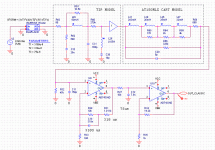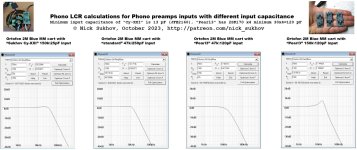Sorry Leoniv, I’m not sure what you are comparing, maybe you can add the simulation schematics that you used.
On top of that, one swallow doesn’t make a summer, Carts differ significantly from one to another, so taking just one Cart to prove a thesis won’t do by far.
Hans
On top of that, one swallow doesn’t make a summer, Carts differ significantly from one to another, so taking just one Cart to prove a thesis won’t do by far.
Hans
It seems to me that the idea of a 150k load for a cartridge is very good. This shifts the LR cut-off frequency outside the sound range and it is no longer necessary to adjust the fall of the frequency response with LC. In this case, the cart impedance less affects the frequency response, all cartridges become more similar. For perfectionists, it is possible to provide the adjustment of frequencies near 20 kHz to suppress mechanical resonance or compensate the frequency loss. The only drawback is that this method does not tolerate the cable.
Simulation schematics attached.
Simulation schematics attached.
Attachments
I'll have a look at the simulations, but I have to repeat that what works for one specific cart, tells nothing what it will mean to other carts.
Hans
Hans
OK, if you want I answer.
Cy-XXI phono preamp advantages over X-Altra and Pearl3 are
1. Passive cooling ultra low capacitance input 150k/25pF : 5 dB Nyquist bonus to S/N ratio + no need of input LCR resonance adjustment for flat FR up to 38 kHz
2. Double differential stages scheme : high PSRR \ no add noises and ripples from simple PS as well as from drain current source noise
3. Output TransAdmittance stage with ActiPassive constant 40 dB loop gain RIAA EQ : ultralow THD with large overload margin, good RIAA accuracy, no THD increase @ LF, no problems with HF stability
4. No electrolytes: good sound and very compact size 20x45x3 mm suitable for freely installation @ tonearm basement of any turntable, - like Phaedrus Phlux / Clearaudio Absolute Phono but without the need to modify headshell\tonearm: no external interference/noise on the interconnect cable and no loss of signal quality
5. Newest JFE2140 input JFETs have Gfs/Ciss ratio 2.31 mS/pF as compared with LSK389`s 0.8 mS/pF and 2SK170`s 0.73 mS/pF. In Cy-XX phono preamp with 8 mA drain current JFE2140 has fourth root of (8/1.5)=1.52=3.64 dB less noise than LSK389 with 1.5 mA drain current as used in X-Altra MM input. That is to say two paralleled LSK389 have more noise than single JFE2140.
6. Real measured SNR 82 dB unweighted [] . Сalculated SNR in strict accordance with the metrological requirements of IEC 61938, GOST 24838 and IEC 61606-3 is 86.2 dbA IEC-A wtd [ https://www.patreon.com/posts/86997687 ].
The claims are nonsense Nick.
I completely agree, and therefore I asked here to post the results of practical measurements of the frequency response for as many cartridges as possible with a load of 150K. So far, no one has reported significant deviations of the FR at such a load.
Even without test LP, you can measure the "electric" FR, adding a small resistor to the GND cartridge pin and by applying a signal through the anti-RIAA. There is an opinion that alignment of such a FR is enough, the mechanical properties of the cartridge affect weakly. The classic load 47k 150-200pF more eliminates the "electrical" fall in the FR due to LR than suppresses the mechanical resonance.
Even without test LP, you can measure the "electric" FR, adding a small resistor to the GND cartridge pin and by applying a signal through the anti-RIAA. There is an opinion that alignment of such a FR is enough, the mechanical properties of the cartridge affect weakly. The classic load 47k 150-200pF more eliminates the "electrical" fall in the FR due to LR than suppresses the mechanical resonance.
Leoniv, mechanical resonance isn't simply a bump in FR. It's the point where FR starts to fall by 12dB/oct. Even if you move electrical resonance infinitely high, you still can't avoid the cliff. Yes, it will be less steep than 24dB/oct but it won't help much.
I think it’s better to discuss this issue on the example of real frequency response of different cartridges. Unfortunately, I don’t have them at hand now to measure.
MM carts are intentially made to be terminated with 47k
The only single variable left to the user is the capacitive load.
Let’s keep it that way and completely forget about lower and higher loads, some needing even adapted riaa correction.
Deviation from 47K will let you drift away from a well thought out universal solution.
Hans
P.s. tonight I will have the time to go through your simulations and get back to you.
The only single variable left to the user is the capacitive load.
Let’s keep it that way and completely forget about lower and higher loads, some needing even adapted riaa correction.
Deviation from 47K will let you drift away from a well thought out universal solution.
Hans
P.s. tonight I will have the time to go through your simulations and get back to you.
Why did it happen to MM cartridges? After all, load 47 K strongly affects the sound range of frequencies. It seems to me that the RC load was decided in order to make it possible to use a cable that has a capacitance. The cable C, along with the cartridge L, forms a resonant peak, for the suppression of which a load of 47K was needed. The manufacturers had no choice. And if we do not use the cable, we can do what kind of load we want. With a load of 150k and the minimum possible capacity, you can not adjust anything to the cartridge at all. I would like to see more real measurements, but I think that the average FR will be no worse than with 47k and adjusting C. A similar method is used in PHLUX active phono cartridges.
For myself, I make an MM-phonopreamp with zero input resistance, there are also good results, but, unfortunately, it requires adjustment for each cartridge. But it is enough to make it "electrically", it does not affect high frequencies.
For myself, I make an MM-phonopreamp with zero input resistance, there are also good results, but, unfortunately, it requires adjustment for each cartridge. But it is enough to make it "electrically", it does not affect high frequencies.
Here you are with a compare between 150K//25pF and 47K//75pF.
This Cart happens to be one that needs a low capacitance, that's why your 150K//25pF still performs reasonable.
But 47K//75pF gives a much flatter response of -0.25dB/+0.52dB up to 20Khz, instead of -0dB/+2,25dB for 150K//25pF.
Hans
This Cart happens to be one that needs a low capacitance, that's why your 150K//25pF still performs reasonable.
But 47K//75pF gives a much flatter response of -0.25dB/+0.52dB up to 20Khz, instead of -0dB/+2,25dB for 150K//25pF.
Hans
Attachments
The result for 150k is quite acceptable. It must be taken into account that for 47k it was necessary to select C. For 150k, the minimum C is simply used. At the same time, the peak is obtained at a frequency of 20 kHz and higher, which will not be noticeable by ear. In real cartridges, this peak is not so high due to losses in the core.
Classic vs TIA:
Classic vs TIA:
Attachments
+2.25dB at 20 kHz is quite acceptable. Are frequency losses taken into account?
Benefit - there is no need to select C.
Benefit - there is no need to select C.
Don`t you agree with Nyquist sqrt(4kTB/R) ? 47k = 0.5868 pA/sqHz , 150k = 0.3284 pA/sqHz. 3284/5868 = 0.5596 = -5.04 dB. Or may be you don`t agree with Ohm, Kirchhoff, Johnson, Horovitz, Hill ?The claims are nonsense Nick.
Nick,
Simply accept that anything above 75dB-A S/N with Cart connected, although relatively easy to achieve with modern components, makes no sense because of the surface noise produced by Vinyl.
And with the lifted arm in the air, this 75dB-A is dead silent.
Hans
Simply accept that anything above 75dB-A S/N with Cart connected, although relatively easy to achieve with modern components, makes no sense because of the surface noise produced by Vinyl.
And with the lifted arm in the air, this 75dB-A is dead silent.
Hans
here I am with my comparison.Here you are with a compare between 150K//25pF and 47K//75pF
Attachments
NicK,
You heavily disappoint me in pretending that a Cart is only composed of Lcart and Rcart.
Those graphs are telling nothing at all and way off to a real transfer function, as can be seen in both examples that I have shown in #130 and #132.
Hans
You heavily disappoint me in pretending that a Cart is only composed of Lcart and Rcart.
Those graphs are telling nothing at all and way off to a real transfer function, as can be seen in both examples that I have shown in #130 and #132.
Hans
Everything that is above 15 - 16 kHz does not have any effect on ear. Here we are fighting for a smooth FR near 20 kHz only for the love of art.Are you sure? Did you make listening test?
- Home
- Source & Line
- Analogue Source
- Pros and cons: prime MM\MC phonopreamps "X-Altra" & "LP797" vs "Cy-XXI"








